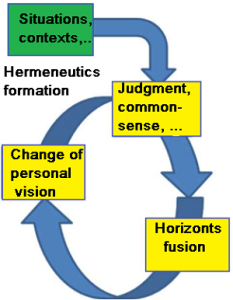
Hermeneutics, common sense and training.
With the concept of common sense, he will use another guiding concept: judgment, and will use for it something of Kant, after having criticized it, for him to judge: “it is, in short, not so much a faculty, but a requirement to be presented To all “(page 78).
use for it something of Kant, after having criticized it, for him to judge: “it is, in short, not so much a faculty, but a requirement to be presented To all “(page 78).
Finally it will present the concept guides: judgment to taste, here it clarifies clearly that it is not an ideal concept, nor a ‘matter of taste’, but something social:
“Taste is not only the ideal that presents a new society, but in the first place, under the sign of this ideal of ‘good taste’, what has been called ‘good society’ (page 84), Gadamer passed away in 2002 but could well serve for today.
If not ideal how to get at it? And he responds: “no longer through birth and status, but basically through the communion of his judgments, or rather, knowing how to rise from the foolishness of interests and the privacy of preferences to demand judgment.”
It is not the guiding concept, but the whole phenomenology is based on the experience, that is, the concepts and questions must be development and socially approved, that is:
“The experience has an immediacy that is subtracted from all opinions about its meaning. What we emphatically call experiencing means something unforgettable and irreplaceable, which is basically inexhaustible for an understandable determination of its meaning. “(Page 126), and so on.” Something is actually gained in each experience. “(P.
It is from this formulation that the idea of horizons, and fusion of horizons, will emerge, emphasizing that it is a particular concept of situation, which in dialogue with another means its position:
“This is not a real dialogue; One does not seek the understanding of a theme, since the objective contents of the dialogue are but one way of knowing the horizon of the other … the other becomes comprehensible in its opinions, from the moment it became recognized Its position and horizon, without, however, implying that we have come to understand ourselves with it … “(page 553)
But before concluding Volume I, I will try to answer fundamental questions: “Is it a correct and sufficient description of the art of historical understanding, that it is necessary to learn to move to other horizons? Is it possible to say, in this sense, that there are closed horizons? “(Page 554), which recalls Nietzsche’s objections to historicism and its” closed “connection with myth, and will clarify that all historical understanding of the Enlightenment was not If not the romantic perspective of the solitary individual, just as the closed horizon “which would surround a culture is an abstraction” (p. 455), since the “horizon is before, something in which we tread our way and with us make the way” (Idem), that is, our goal.
This is not a summary, not even a drop of Gadamer’s thought, but here we try to delineate some reading keys in order to indicate a mature and fruitful contemporary thought.
GADAMER, H.G. Truth and Method, London,New York: Continuum, 1975. (pages in Brazilian Edition









